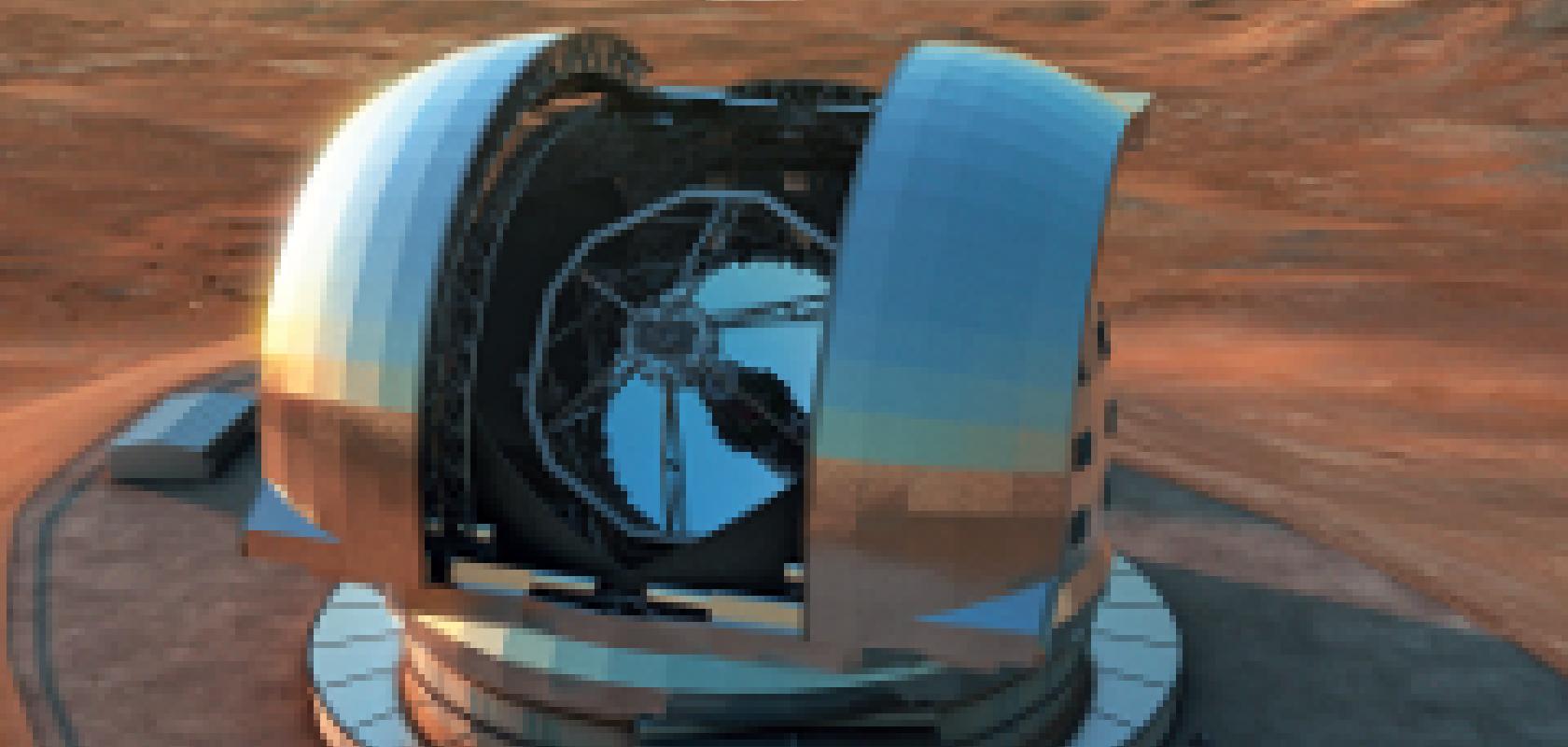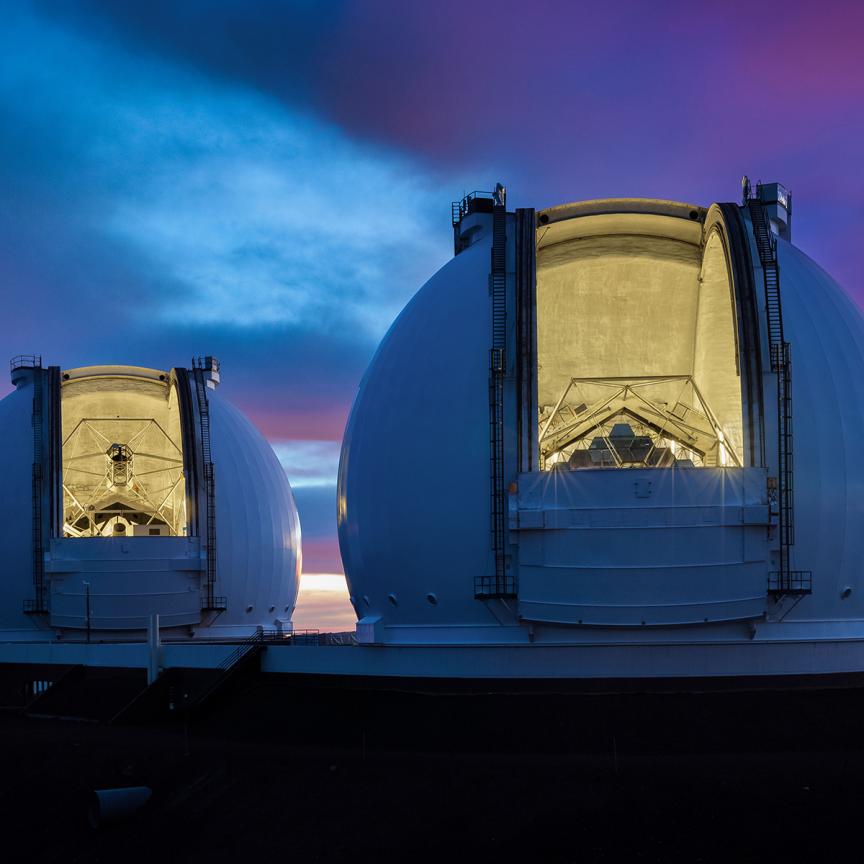At the UK’s Photonex conference in October, David Walker, Professor of Optics at Glyndwr University in Wales, announced that the European Southern Observatory (ESO) had approved the first components of a telescope whose construction will bolster the European optics industry – and, ultimately, transform our perception of the universe.
With construction of the European Extremely Large Telescope (E-ELT) due to begin next year, the ESO explicitly sees this project – the largest optical infrared telescope in the world – not only as a boost to science but also to European technological capacity. According to Marc Cayrel, project manager for the E-ELT optics at ESO: ‘We will use European industries to manufacture the optics used in the E-ELT. Making a telescope is not only to help science, but to reinforce our industry within Europe. Building the E-ELT is an opportunity to strengthen the European optics industry.’
The UK’s National Facility for Ultra Precision Surfaces, operated by Glyndwr
University in partnership with University College London and precision polishing company Zeeko, has been responsible for manufacturing prototype mirror segments for the E-ELT. Walker told the Photonex conference, in Coventry, UK: ‘The acceptance tests have been conducted on the first segment and we received the formal certificate of acceptance from ESO on the 15th October.’
The primary mirror, measuring 39 metres, will be segmented because it is not feasible to build such a large mirror in one piece. As Walker, who is also professorial research associate of University College London and research director at Zeeko, says: ‘You would not try to buy one enormous tile to go on your bathroom wall; you would buy a box of tiles and put them on the wall. It is exactly the same; these very big telescopes are always segmented.’
The next stage will be to produce the segments on a larger scale. ESO’s design of the E-ELT is now well-advanced, and the preliminary specifications for the optics are available. The tender for the primary mirror segments is anticipated for 2014/15, and the two main organisations in Europe that can fabricate these optics are Sagem in France and the UK’s National Facility. However, it is implausible that a university would be given a contract for mass-production of the segments – so segment manufacture, or process-stages, might be split between vendors. Walker says: ‘After finishing the prototype, we are currently in the process of investigating partnerships with optics fabricators, under which a partner company would take on the technology and establish a new manufacturing facility.’
The E-ELT is due for completion in 2022 and it will take six years to manufacture the optics. The telescope will need 931 segments, including the spares, and Walker explains that the industry would struggle to produce such optics at a rate of about three per week: ‘If I go out to tender today for just one of those segments, I would probably be quoted 15 months’ delivery time.’ Moreover, he remarks: ‘Look at the worldwide experience of delivery-time of large optics, and the history of damage to surfaces in manufacture.’ To then scale up to the E-ELT, which has nearly 1,000 segments that have larger and more complex surfaces, creates a significant challenge. ‘You see that this classical approach to manufacture is no longer appropriate,’ says Walker. ‘In other words we need a whole new way of thinking about optical manufacture.’
Automation and mass production technologies need to be brought to optics. Walker comments: ‘When working with such parts, 0.5m and upwards, there tend to be bespoke processes and manual interventions. What we are trying to do is to move forwards by thinking “how should we be carrying out this work on the big scale?”’ The new process developed for the prototype E-ELT segment by the team at the UK National Facility has taken a step in this direction. Manual intervention and handling of segments has been reduced, so there is more automation and less scope for damage. Walker explains: ‘With further development, which is underway at the moment, we believe the process chain that we have developed will end up as a faster process. This approach will ultimately have an effect on the optics industry.’
In the finished telescope, each segment will have a unique location where it must be held securely and without distortion so that the ensemble will function as a single giant ellipsoidal mirror. It is vital to control the form of the segment edges because edge-roll, the distortion of the optical surface in the region near the transition, degrades stray-light and IR-emissivity performance. The primary mirror will be made out of 798 segments, which are all 1.4m in size, corner to corner, and 50mm thick.
One of the key goals for the E-ELT project is to identify extra-solar terrestrial planets, and a large aperture is a key parameter in getting the high resolution needed to achieve this. The individual mirror segments must be aligned so that the gaps between them are reduced to within a small fraction of a wavelength. If the segments are not correctly in phase, only the resolution equivalent to the aperture of a single one of the mirror segments would be achieved.
The whole telescope is considered to be an on-axis system because everything is axis-symmetric, but any individual optic by itself is off-axis; i.e. the optical axis and the mechanical centre of the aperture are not aligned. John Filhaber, internal astronomical systems expert at optical metrology company Zygo, explains: ‘When you say off-axis and asphere in the same sentence it strikes fear into the hearts of optical engineers and optical manufacturers everywhere.’ In terms of manufacturability, there are two processes involved in making these off-axis segments: ‘Vibration insensitive aspheric metrology is essential to be able to handle the task of measuring the off-axis aspheric segments,’ explains Filhaber. ‘But, you also need advanced computer controlled polishing (CCP) equipment to finish these mirrors to within a few tens of nanometres.’
The team in Glyndwr has developed technologies to overcome these challenges. This was achieved with a new process chain, which was demonstrated on subscale parts, and then developed on full-scale equipment. Walker says: ‘We have conquered for the first time the challenge of controlling the edges of the segments in polishing.’ The UK National Facility is polishing the segments as hexagons all the way through. Polishing large parts and maintaining good edges was previously deemed to be unfeasible, because polishing tends to roll edges down. This hexagonal shape avoids intermediate handling of the segment, reducing risk of accidental damage, and circumvents the need for ion-figuring. Therefore, it has the potential to be easily scaled up for integrated segment mass production, with a high level of automation.
The process starts with ultra-precision grinding of the off-axis asphere on the pre-cut hexagonal segment. This is carried out with the BoX machine, designed and developed by Cranfield University and manufactured by Cranfield Precision. Then, the segment is polished and corrected on a 1.6m-capacity IRP1600 Zeeko Computer Numerical Control (CNC) polishing machine – the first machine built of this size. Bonnet polishing with variable spot-size capability was used, in combination with a local smoothing technique. Together, these have demonstrated highly-effective control of overall form, mid-spatial frequencies, edges and local texture.
A major metrological issue is that the segments have a very long radius of curvature – 84m – ruling out a direct test to measure the centre of curvature. To tackle this problem, the Glyndwr team has compacted full aperture interferometry into a 10m high test tower directly over the IRP1600 machine, allowing the segments to be measured in situ. This is complemented by sub-aperture stitching interferometry and white-light texture interferometry, also conducted on-machine.
Although the segments are being made over a period of six years, the first segment will have to match the last, with no drift in the base radius. Glyndwr is using a custom-built pentaprism scanning-profilometer. This instrument mounts onto the IRP1600 polishing machine, measures the segment in situ, and determines the absolute base radius independently of the interferometry measurements.
‘The metrology has proved to be just as difficult as achieving the edge control,’ says Walker. ‘However, we have excellent metrology, which has been certified by ESO. A benefit is that all the metrology is carried out with the segment on the polishing machine – we don’t have to take the segment off to measure it, meaning fewer inaccuracies caused by handling and less downtime.’
The secondary mirror (M2) creates a separate problem in designing a telescope of this scale. It is four metres, convex, and strongly aspheric. This will be the first time that large convex mirrors are manufactured, because, in other telescopes, four metre mirrors have always been concave. Cayrel at ESO says: ‘We have been working with the industry to decide what would be the best way to test and manufacture such an optic.’
Other optical surfaces proved to be less difficult to design, because they are comparable to existing technologies. The tertiary mirror (M3) is four metres in size, like the M2, but it is classical and similar to the optical design found in other large ESO telescopes, such as the New Technology Telescope (NTT) or the Very Large Telescope (VLT).
The quaternary mirror (M4) is an adaptive mirror about 2.5m in size, which is used to correct – in real time – the effects of the atmospheric turbulence. ‘It will be quite challenging to build, but because other large adaptive mirrors have already been manufactured, such as the VLT secondary mirror, we can just expand that technology from 1m to 2.5m,’ explains Cayrel.
The M5 is a tip-tilt mirror almost three metres in size. This optic needs to be both extremely stiff and extremely lightweight to allow for the tip-tilt corrections which stabilise the image. According to Cayrel: ‘We can benefit from developments that have been made in the past for astronomy, such as the manufacture of extremely lightweight, silicon-carbide optics, and we would use the same type of technology for this.’
As with the primary mirror segments, the manufacture of the M2 mirror is at the limits of the technology of the optics industry, and manufacturing considerations influenced its design, as Cayrel explains: ‘The design of the whole telescope has been made so that the M2 is no larger than four metres, because this would create difficulties in finding potential vendors for polishing and for other optical processes. We focused on a design so that the M2 is feasible without being faced with major challenges from the industry.’
The issues of automation and mass production in large lenses extend way beyond astronomy. The National Ignition Facility (NIF) in the USA is researching nuclear fusion using high-power lasers, and the UK’s HiPER laser-fusion project has been conducting its preparatory stage. This requires substantial quantities of large optics and, because the lasers damage the optics, there are markets in both their manufacture and their refurbishment. Walker believes the project may lead to power generation within the next 30 years or so. ‘What we, and other industries in the UK, are trying to do, is take our existing optical fabrication technologies and explore how they could be used to meet this need,’ he said. ‘Large optics is not just for astronomy, but also for solving the world’s energy crisis.’
 Jessica Rowbury is a technical writer for Electro Optics, Imaging & Machine Vision Europe, and Laser Systems Europe.
Jessica Rowbury is a technical writer for Electro Optics, Imaging & Machine Vision Europe, and Laser Systems Europe.
You can contact her on jess.rowbury@europascience.com or on +44 (0) 1223 275 476.
Find us on Twitter at @ElectroOptics, @IMVEurope, @LaserSystemsMag and @JessRowbury.


